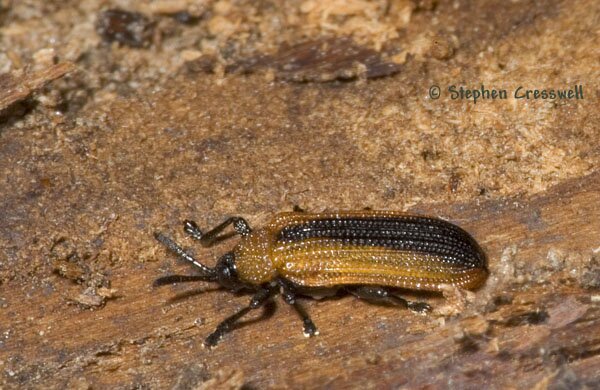
Family: Chrysomelidae
Subfamily: Hispinae
Length: 5.5-6.5 mm
The antennae, legs, and head of Odontota dorsalis are black. The pronotum and elytra are yellowish brown, while the elytra have a black sutural stripe. The pronotum is widest at base. The elytra at the base are wider than the pronotum. The elytra are so punctate as to have a waffled appearance. This waffled appearance is also found in a related West Virginia species, Sumitrosis inaequalis.
The common name refers to the larva's practice of tunneling and feeding between the two surfaces of Locust leaflets. The larva feeds not only on Black and Honey Locust, but also on other members of the legume family, including Beans, Peanuts, and Clover. In a 1938 experiment, adults of this species were induced to feed in the laboratory on species of Birch, Oak, Mulberry, Crab Apple, and Elm, but on this diet they did not produce eggs.
Fritz (1983) reported that in western Maryland Odontota dorsalis overwinter as adults, and in May begin to feed on the leaflets of Black Locust. In June, eggs are attached to the underside of leaves and are hidden by a layer of excrement. In about ten days the eggs hatch, and the larvae begin mining between the upper and lower surfaces of the leaflet. Often the larva must move to a new leaflet because three to five siblings are also mining in the same leaflet and the food begins to run out. There are three larval instars. Pupation takes places inside the leaflet, and adults emerge in the latter part of July. Fritz found that Odontota dorsalis produces one generation per year in Maryland. Commenting on the damage done by this species, Fritz added that "Defoliation of black locust by beetle larvae greatly exceeds defoliation by adults."

Insects of West Virginia